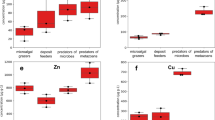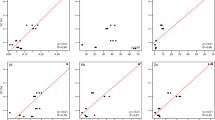Abstract
Microcosms were used to assess the impact of chromium on free-living marine nematodes. Nematodes were exposed to three chromium concentrations (500 ppm (dm, dry mass), 800 ppm (dm) and 1,300 ppm (dm)), and effects were examined after 4 weeks. Results showed significant differences between univariate measures of control nematodes and those from medium- and high-chromium microcosms. Most, decreased significantly with increasing level of chromium contamination. The medium-chromium treatment seems to be the minimal concentration that could has a negative effect on nematodes. Results from multivariate analyses demonstrated that responses of nematode species to chromium treatments were varied: Leptonemella aphanothecae was eliminated at all doses tested and seemed to be intolerant species to chromium; Daptonema normandicum and Sabatieria longisetosa which significantly increased at 500 ppm chromium (dm) appeared to be “opportunistic” species at this dose whereas the two Bathylaimus species (Bathylaimus capacosus and Bathylaimus tenuicaudatus) which increased at all the doses tested seemed to be “chromium resistant”. As we think such “opportunistic” and “resistant” species could be used as sensitive indicators of unsafe marine food. The use of microcosms has allowed the effects of the chromium on nematodes to be assessed individually, which was not possible in the field.




Similar content being viewed by others
References
Biedermann KA, Landolph JR (1990) Role of valence state and solubility of chromium compounds on induction of cytotoxicity, mutagenesis, and anchorage independence in diploid human fibroblasts. Cancer Res 50:7835–7842
Anderson RA (1998) Chromium, glucose intolerance and diabetes. J Am Coll Nutr 17:548–555
Anderson RA (2003) Chromium and insulin sensitivity. Nutr Res Rev 16:267–275
Cefalu WT, Hu FB (2004) Role of chromium in human health and in diabetes. Diabetes Care 27:2741–2751
Pittler MH, Stevinson C, Ernst E (2003) Chromium picolinate for reducing body weight: meta-analysis of randomized trials. Int J Obes Relat Metab Disord 27:522–529
Smart GA, Sherlock JC (1985) Chromium in foods and the diet. Food Add Contam 2:139–147
Jordao CP, Pereira JL, Jham GN (1997) Chromium contamination in sediment, vegetation and fish caused by tanneries in the State of Minas Gerais, Brazil. Sci Total Environ 207:l–11
Tam NFY, Wong YS (1995) Spatial and temporal variations of heavy metal contamination in sediments of a mangrove swamp in Hong Kong. Mar Poll Bull 31:254–261
Armienta MA, Rodrlguez R, Ceniceros N, Jufirez F, Cruz O (1996) Distribution, origin and fate of chromium in soils in Guanajuato, Mexico. Environ Pollut 91(3):391–397
Lytle JS, Lytle TF (2001) Use of plants for toxicity assessment of estuarine ecosystems. Environ Toxicol Chem 20:68–83
McClusky DS, Elliot M (2004) The estuarine ecosystem: ecology, threats and management. Oxford University Press Inc., New York
Jardim WF (1983) Poluicao aquatica: metais pesados, urn dano irreparavel. Rev Bras Tecn 14:41–45
Kirpnick-Sobol Z, Reliene R, Schiestl RH (2006) Carcinogenic Cr(VI) and the nutritional supplement Cr(III) induce DNA deletions in yeast and mice. Cancer Res 66:3480–3484
Zhitkovich A, Quievryn G, Messer J, Motylevich Z (2002) Reductive activation with cysteine represents a chromium(III)-dependent pathway in the induction of genotoxicity by carcinogenic chromium(VI). Environ Health Perspect 110(suppl 5):729–731
Tsou TC, Yang JL (1996) Formation of reactive oxygen species and DNA strand breakage during interaction of chromium(III) and hydrogen peroxide in vitro: evidence for a chromium(III)-mediated Fenton-like reaction. Chem Biol Interact 102:133–153
Moens T, Vincx M (1997) Observations on the feeding ecology of estuarine nematodes. J Mar Biol Ass UK 77:211–227
Bouwman LA, Romeyn K, Kremer DR, Es FB (1984) Occurrence and feeding biology of some nematode species in estuarine communities. Cah Biol Mar 25:287–303
Rivain V (1984) Etude expérimentale de l’action d’un prédateur endogé sur le méiobenthos temporaire. Oceanis 10(3):259–277
Albertini-Berhaut J (1974) Biologie des stades juvéniles des Téléostéens Mugilidae Mugil auratus R 1810 Mugil capito C 1829 et Mugil saliens R 1810. II. Modification du régime alimentaire en relation avec la taille. Aquaculture 4:13–27
Fitzhugh GR, Fleeger JW (1985) Goby (Pisces: Gobiidae) interactions with meiofauna and small macrofauna. Bull Mar Sci 36(3):436–444
Lee MR, Correa JA (2005) The effects of copper mine tailings disposal on littoral meiofaunal assemblages in the Atacama region of northern Chile. Mar Environ Res 59:1–18
Mahmoudi E, Essid N, Beyrem H, Hedfi A, Boufahja F, Vitiello P, Aïssa P (2005) Effects of hydrocarbon contamination on a free-living marine nematode community: results from microcosm experiments. Mar Poll Bull 50:1197–1204
Mahmoudi E, Essid E, Beyrem H, Hedfi A, Boufahja F, Vitiello P, Aïssa P (2007) Individual and combined effects of lead and zinc of a free living marine nematode community: results from microcosm experiments. J Exp Mar Biol Ecol 343:217–226
Beyrem H, Mahmoudi E, Essid N, Hedfi A, Boufahja F, Aïssa P (2007) Individual and combined effects of cadmium and diesel on a nematode community in a laboratory microcosm experiment. Ecotoxicol Environ Saf 68:412–418
Beyrem H, Louati H, Essid N, Aïssa P, Mahmoudi E (2010) Effects of two lubricant oils on marine nematode assemblages in a laboratory microcosm experiment. Mar Environ Res 69:248–253
Hedfi A, Mahmoudi E, Boufahja F, Beyrem H, Aïssa P (2007) Effects of increasing levels of nickel contamination on structure of offshore nematode communities in experimental microcosms. Bull Environ Contam Toxicol 79:345–349
Hermi H, Mahmoudi E, Beyrem H, Aïssa P, Essid N (2009) Responses of a free-living marine nematode community to mercury contamination: results from microcosm experiments. Arch Environ Contam Toxicol 56:426–433
Howell R (1982) Levels of heavy metal pollutants in two species of marine nematodes. Mar Pollut Bull 13:396–398
Howell R (1983) Heavy metals in marine nematodes: uptake, tissue distribution and loss of copper and zinc. Mar Pollut Bull 14:263–268
Fichet D, Boucher G, Radena G, Miramand P (1999) Concentration and mobilisation of Cd, Cu, Pb and Zn by meiofauna populations living in harbour sediment: their role in the heavy metal flux from sediment to food web. Sci Total Environ 243(244):263–272
Coull BC, Chandler GT (1992) Pollution and meiofauna: field, laboratory and mesocosm studies. Oceanogr Mar Biol 30:191–271
Long ER (1992) Ranges in chemical concentrations in sediments associated with adverse biological effects. Mar Poll Bull 24:38–45
Suderman K, Thistle D (2003) Spills of fuel oil-6 and Orimulsion can have indistinguishable effects on the benthic meiofauna. Mar Poll Bull 46:49–55
Boufahja F, Beyrem H, Essid N, Amorri J, Mahmoudi E, Aïssa P (2007) Morphometry, energetics and diversity of free-living nematodes from coasts of Bizerte lagoon (Tunisia): an ecological meaning. Cah Biol Mar 48:121–137
NOAA (1999) Screening Quick Reference Tables (SQuiRTs). Coastal Protection & Restoration Division, NOAA, USA
Beyrem H, Aïssa P (2000) Les nématodes libres, organismes-sentinelles de l’évolution des concentrations d’hydrocarbures dans la baie de Bizerte (Tunisie). Cah Biol Mar 41:329–342
Austen MC, McEvoy AJ, Warwick RM (1994) The specificity of meiobenthic community responses to different pollutants: results from microcosm experiments. Mar Pollut Bull 28:557–563
Yoshida M, Hamadi K, Ghrabi A (2002) Solid waste landfills and soil/sediment contamination around Bizerte lagoon: possible pollution sources. Study on environmental pollution of mediterranean coastal lagoons. JICA Research Promotion Programme (RPP-SEPMCL), Initial Report. pp 55–75
Schratzberger M, Warwick RM (1998) Effects of intensity and frequency of organic enrichment on two estuarine nematodes communities. Mar Ecol Prog Ser 164:83–94
Carman KR, Fleeger JW, Means JC, Pomarico SM, McMillin DJ (1995) Experimental investigation of the effects of polynuclear aromatic hydrocarbons on an estuarine sediment food web. Mar Environ Res 40:289–318
Millward RN, Carman KR, Fleeger JW, Gambrell RP, Portier RJ (2004) Mixtures of metals and hydrocarbons elicit complex responses by a benthic invertebrate community. J Exp Mar Biol Ecol 310:115–130
Wieser W (1960) Benthic studies in Buzzards Bay. II. The meiofauna. Limnol Oceanogr 5:121–137
Vitiello P, Dinet A (1979) Définition et échantillonnage du méiobenthos. Rapp Comm Int Mer Médit 25:279–283
Andrassy I (1956) Die Rauminshals-und Gewichtbestmmung der Fadenwürmer (Nematoden). Acta Zool Hung 2(1/3):1–15
Juario JV (1975) Nematode species composition and seasonal fluctuation of a sublittoral meiofauna community in the German Bight. Veröff Inst Meeresforsch Bremerh 15:283–337
Platt HM, Warwick RM (1983) ‘Free living marine nematodes. Part I. British Enoplids’. Synopses of the British Fauna no 28. Cambridge University Press, Cambridge
Platt HM, Warwick RM (1988) Free living marine nematodes. Part II. British Chromadorids.’ Synopses of the British Fauna no 38. E. J Brill, Leiden
Warwick RM, Platt HM, Somerfield PJ (1998) Free living marine nematodes. Part III. British Monhysterida. Synopses of the British fauna no 53. Field Studies Council, Shrewsbury
Clarke KR (1993) Non-parametric multivariate analyses of changes in community structure. Aust J Ecol 18:117–143
Clarke KR, Warwick RM (2001) Changes in marine communities: an approach to statistical analysis and interpretation, 2nd edn. PRIMER-E, Plymouth, UK
Lambshead PJD, Platt HM, Shaw KM (1983) The detection of difference among assemblages of marine benthic species based on assessment of dominance and diversity. J Nat Hist 17:859–874
Austen MC, Somerfield PJ (1997) A community level sediment bioassay applied to an estuarine heavy metal gradient. Mar Environ Res 43:315–328
Millward RN, Carman KR, Fleeger JW, Gambrell RP, Powell RT, Rouse M-AM (2001) Linking ecological impact to metal concentrations and speciation: a microcosm experiment using a salt marsh meiofaunal community. Environ Toxicol Chem 20:2029–2037
Austen MC, McEvoy AJ (1997) The use of offshore meiobenthic communities in laboratory microcosm experiments: response to heavy metal contamination. J Exp Mar Biol Ecol 211:247–261
Schratzberger M, Rees HL, Boyd SE (2000) Effects of simulated deposition of dredged material on structure of nematode assemblage—the role of contamination. Mar Biol 137:613–622
Hedfi A, Mahmoudi E, Beyrem H, Boufahja F, Naceur E, Aïssa P (2008) Réponse d’une communauté de nématodes libres marins à une contamination par le cuivre: étude microcosmique. Bull Soc Zool Fr 133(1–3):93–102
Carr RS, McCulloch WL, Neff JM (1982) Bioavailability of chromium from a used chrome lignosulphonate drilling mud to five species of marine invertebrates. Mar Environ Res 6:189–203
Hadjispyrou S, Kungolos A, Anagnostopoulos A (2001) Toxicity, bioaccumulation, and interactive effects of organotin, cadmium and chromium on Artemia franciscana. Ecotoxicol Environ Saf 49:179–186
Schratzberger M, Wall CM, Reynolds WJ, Reed J, Waldock MJ (2002) Effects of paint-derived tributylin on structure of estuarine nematode assemblage in experimental microcosms. J Exp Mar Biol Ecol 272:217–235
Melo SLR, Nipper M (2007) Sediment toxicity tests using the burrowing amphipod Tiburonella viscana (Amphipoda: Platyischnopidae). Ecotoxicol Env Saf 66:412–420
Melville F, Pulkownik A (2007) Investigation of mangrove macroalgae as biomonitors of estuarine metal contamination. Sci Total Environ 387:301–309
Bat L, Raffaelli D (1998) Sediment toxicity testing: a bioassay approach using the amphipod Corophium volutator and the polychaete Arenicola marina. J Exp Mar Biol Ecol 226:217–239
Chapman PM, Wang F, Janssen C, Persoone G, Allen HE (1998) Ecotoxicology of metals in aquatic sediments: binding and release, bioavailability, risk assessment, and remediation. Can J Fish Aquat Sci 55:2221–2243
Acknowledgments
We are grateful to Prof. Guy Boucher (National Museum of Natural History-Paris) for assistance on species identification. We thank the anonymous referees for critically reading and commenting on an earlier version of this manuscript.
Author information
Authors and Affiliations
Corresponding author
Rights and permissions
About this article
Cite this article
Boufahja, F., Hedfi, A., Amorri, J. et al. An Assessment of the Impact of Chromium-Amended Sediment on a Marine Nematode Assemblage Using Microcosm Bioassays. Biol Trace Elem Res 142, 242–255 (2011). https://doi.org/10.1007/s12011-010-8762-6
Received:
Accepted:
Published:
Issue Date:
DOI: https://doi.org/10.1007/s12011-010-8762-6




